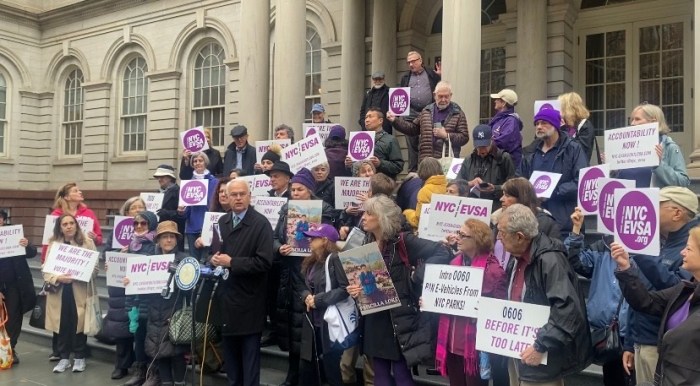By Helen Klein
Crediting innovative approaches that substitute rehabilitation for traditional jail time for a percentage of the borough’s steep drop in serious crime since 1990, Brooklyn District Attorney Charles “Joe” Hynes took his show on the road, with a Power Point presentation featuring some of his office’s signature programs. Speaking to members of the Knights of Pythias, Genesis Lodge # 64, gathered at Canarsie’s Temple Emanuel, 1880 Rockaway Parkway, Hynes stressed that, early in his tenure as D.A., “I realized you couldn’t imprison your way to public safety.” To that end, Hynes said, he engaged in a wholesale “Redefinition of what a prosecutor’s office is. Slowly but surely, this redefinition is beginning to take hold.” Hynes – who said he had initially run for the office of D.A. in 1989, “As an angry crime victim” — cited numerous programs that have helped the borough’s annual serious crime rate plummet from over 158,000 instances in 1990 to 42,511 in 2004. In 1990, according to the presentation, one out of every 15 people had been a victim of a serious crime. By 2004, according to the presentation, one out of every 60 people in the borough was a crime victim. Similarly, the homicide rate in 1990 was 33 per 100,000 people (a total of 765), compared to 2004’s nine per 100,000 people (a total of 231). A particularly poignant statistic cited by Hynes involved the murders of children. In 1991, he said, 151 children age 19 or younger were murdered in Brooklyn. “One hundred and 29 died by gunfire,” stressed Hynes. “You didn’t read about it. No one was covering it because it was commonplace.” What’s made the difference? Certainly, citywide, crime has dropped sharply over the past decade or longer. Overall, according to New York Police Department statistics, the seven index crimes (murder, rape, robbery, felonious assault, burglary, grand larceny and grand larceny auto) are down a whopping 70.69 percent over the past 12 years. In that same period, crime decreased 68.53 percent in Patrol Borough Brooklyn North and 70.36 percent in Patrol Borough Brooklyn South. But, said Hynes, a culture of cooperation across the borough had had an impact in reducing crime. “Do you remember when you were afraid to go out because you could become the victim of a robbery?” Hynes asked. That has changed, he said, and, “The reason that every police officer will tell you, everyone in the DA’s office will tell you, is community support. The key is community involvement. There was a time when many communities and the police and the DA’s office were at war. That’s changed. A major reason why we have safer communities is that we work together now.” In addition, said Hynes, initiatives such as DTAP, ComAlert, and Project Respect have also played a part in putting a lid on serious crime. In such programs, the goal, he said, was to reduce recidivism. When he took office, Hynes recalled, “Drugs were the reason why crime had gone through the roof.” To counter that, he said, the DA’s office differentiated between low-level dealers and “people who sell drugs for profit alone – for those people, no plea bargaining, I don’t want to hear about your tough growing up.” For the former, however, the office crafted DTAP – the Drug Treatment Alternative to Prison, which Hynes characterized as, “A sensible way of taking people out of the criminal justice system and putting them into long-term drug rehabilitation. Then, we added something that really made a significant difference. We added job training and job placement. If you have a job, you’re not likely to be involved in crime.” Of the 2,000 individuals accepted into DTAP, said Hynes, 823 have graduated from the program and 335 are currently in treatment. For the 800-plus graduates, said Hynes, there have been significant financial benefits – a savings of over $32 million. “Do you know what it costs to put someone in Rikers Island for a year?” asked Hynes. “Ninety eight thousand dollars.” And, said Hynes, the National Center on Addition and Substance Abuse at Columbia University had studied DTAP for five years. “They said it was the most effective drug treatment modality in the country,” Hynes reported. Among the statistics Hynes trumpeted – “DTAP graduates had re-arrest rates that were 33 percent lower and were 87 percent less likely to return to prison two years after graduation as compared to a matched comparison group.” His ComAlert program Hynes call, “Probably the most exciting thing that has happened in the criminal justice system in my memory. When somebody comes out of prison, as they ultimately do at the rate of 3,000 a year coming back to Brooklyn,” he explained, “your choice is let them wander around the streets – they don’t get any kind of service help for 45 days, because it takes that long to get on Medicaid, and you put them in a position where they will invariably get re-arrested. “In the course of getting re-arrested,” Hynes went on, “they are making you victims and putting cops into harm’s way. It was suggested to me, a couple of years ago, wouldn’t it be a smarter idea to put these returnees with volunteer agencies that would provide services that would lead them to have stabilized lives. The key to public safety is recidivism reduction. “We began with this program, a couple of hundred people a year, put with volunteer agencies, to see if we could lower the recidivism rate,” said Hynes. While New York State, as a whole, has a recidivism rate of 60 percent, said Hynes, and the city had a recidivism rate is 41 percent, in ComAlert it is 22 percent. “We just increased the numbers, so we can put almost 1,000 more people into this program,” Hynes added. “More than one-third of the returnees in a program that has a recidivism rate of 22 percent. You’re talking about an enormous crime wave reduction.” Project Respect is targeted at the prostitution problem. The key to it is providing individuals who have been arrested for patronizing prostitutes with the opportunity to attend what is colloquially called “John school,” where they learn about the consequences of their actions. “If they don’t go to the course, they have got to go to trial,” Hynes explained. The program was kicked off in 2002, and, so far, said Hynes, 1,600 individuals have gone through it. Out of that number, according to the DA, just three have been re-arrested. “They must scare the heck out of them,” remarked Hynes. A newer program designed to tackle prostitution from the prostitute’s side of it is the Brooklyn S.T.A.R. project. Begun in July of 2004, the program whose goal, said Hynes, is to, “divert teenage prostitutes out of that horrible life they have, back to school or to get a job,” provides young women (under the age of 21) with a six-week course detailing the dangers of engaging in prostitution, while backing that up with intensive counseling, medical care, education, job training and housing assistance. “Catholic Charities give us some space, and Long Island College Hospital gives us counselors for these kids,” explained Hynes. “It’s too early to tell if the program is going to have a serious impact but anecdotally I believe it is working. The kids seem to be responding very well.” Besides these programs, Hynes went over a host of others, among them: *The D.A.’s Domestic Violence bureau, with an Elder Abuse unit; *The soon-to-be-opened Family Justice Center which Hynes said is, “Going to be a spectacular expansion of the domestic violence program,” providing “the widest possible safety net for victims of domestic violence;” *The community service unit, which gives those who commit low-level violations an opportunity to learn the consequences of their behavior by “making them do community service;” *TRACK, to deal with truancy from school (now down to “Under 2,000 a day compared to as much as 50,000 at one point,” said Hynes); and, *Youth Congregations in Partnership, which, said Hynes, takes “kids charged with felonies, no weapon,” and instead of incarcerating them, pairs them with a church, synagogue or mosque, which provides such supports as mentoring, job training, anger management and behavior modification. “We are saving money by not putting these people in jail,” Hynes added, noting he had recently attended a graduation of 27 youths from the program. “These kids, all of them, are either in school or working.” Such a result is in keeping with Hynes’ philosophy. “If there’s any mantra for this office,” he told his listeners, “it’s prioritize. Try to take people out of the system in prevention programs, an nail the people who ought to be in jail.”


































